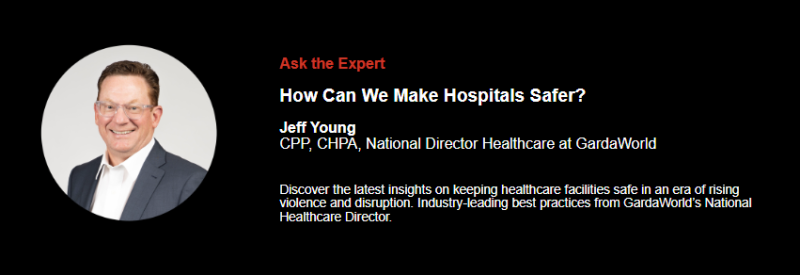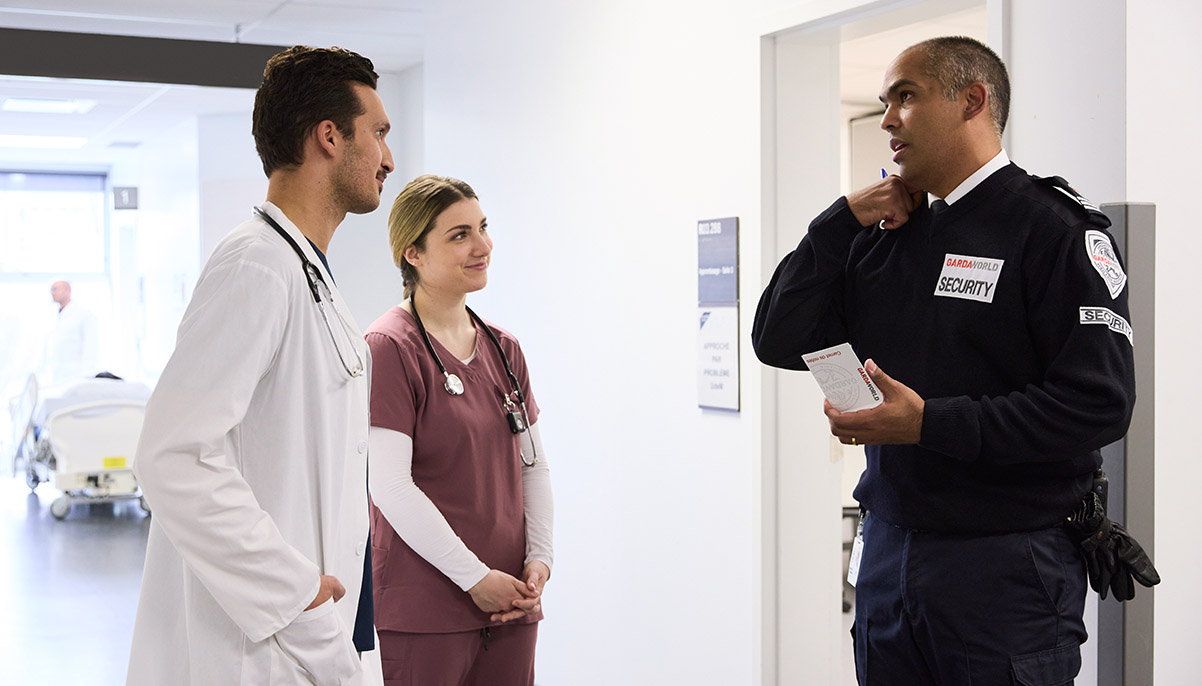
Violence in the healthcare sector is on the rise at alarming rates across North America. From Florida to Toronto, Arizona to British Columbia, a surge in patient-initiated aggression and crime cases are being seen across the board since the pandemic, leaving many healthcare facilities, caregivers, and patients at greater risk than ever before. To help tackle this growing concern, we caught up with GardaWorld’s leading in-house healthcare security expert Jeff Young to weigh in on some of the best practices for keeping hospitals safe in today’s world.
Learn more about GardaWorld’s industry-leading healthcare security services.
8 Best Practices for Better Healthcare Security
In the pursuit of high-quality patient care, healthcare organizations are facing new challenges that have proven highly disruptive to facility operations and compromise the safety for patients and clinicians alike. Among these challenges, a significant increase in Workplace Violence (WPV), a recognized hazard in the healthcare industry, and defined as any act or threat of physical violence, harassment, intimidation, or other threatening disruptive behavior that occurs at the healthcare facility.
“Patient-initiated aggression or violence is the number one risk to mitigate in healthcare today,” says Jeff Young, GardaWorld’s National Director for Healthcare in charge of overseeing program development, operational excellence, and business development for the healthcare sector.
Young proposes the following eight (8) best practices to guide healthcare security professionals in keeping hospitals safe:
1. Understand the importance of healthcare-specific security training.
“A major pain point we hear over and over again from prospective clients across Canada and the United States is not having healthcare-specific training for healthcare security officers,” says Young. For this reason, he explains, GardaWorld has designed a breadth of healthcare-specific training programs, including patient-centric de-escalation techniques, compliance, compassionate care, and physical intervention training, as part of its curriculum.
Watch this video to learn more about GardaWord’s specialized approach to healthcare security.
2. Consider the use of empathy.
“Healthcare is a very, very challenging environment to work within, so a patient-centric approach is really a key part of our training,” says Young, underscoring that some patients are trauma victims and marginalized portions of society who may have already had a history of poor experiences with law enforcement and authority. “It's important to remember that individuals do not choose to come to the hospital; they are here because they’re ill, and sometimes that goes hand-in-hand with behavioral health and mental health that we see that reflected in aggressive behavior,” he explains. “That’s why we train our healthcare security team not to exude enforcement, but rather empathy,” he explains. “We are there to ensure a safe environment for all to support their care.”
3. Respond with Trauma-Informed Care (TIC).
One of the most fascinating fields of research for both healthcare and security has been the study of trauma, trauma survivors and recognition of trauma triggers by security officers. Applying these learnings has been a game-changer in the healthcare security industry, says Jeff Young, citing GardaWorld’s training in Trauma-Informed Care (TIC) as a key factor in the success of GardaWorld’s healthcare security program. By providing extra attention and care to trauma patients whose sense of safety, and ability to regulate emotions and navigate relationships can often be compromised, a human-centered approach in the interactions with patients is favored, explains Young. “Trauma-informed care shifts the focus from ‘What’s wrong with you?’ to ‘What happened to you,’ and I think that's our path forward to help support patients and our staff, especially the focus has to be around that safe management of patient aggression.”
Learn more about How Trauma-Informed Care Can Reduce Violence.
“We train our healthcare security team not to exude enforcement, but rather empathy.”
Jeff Young, CPA, CHPA
National Director, Healthcare, GardaWorld
4. Consider the ED Ambassador Program.
Providing a customer-focused liaison role within emergency departments, where aggression is currently most on the rise, has proven highly effective in enhancing the patient experience and preventing disruptive behavior before it starts. As exemplified through GardaWorld’s partnership with Fraser Health in British Columbia, the Emergency Department (ED) Ambassador program, offered across Canada and the United States by GardaWorld, plays a key role in engaging patient and visitors with respectful and supportive interactions, recognizing aggression at its earliest stages and employs various verbal de-escalation strategies when needed. The program also provides valuable support to ED department staff by monitoring waiting areas to create a positive safety culture, collaborates with clinical and operational stakeholders, and serves as a principal contact for security services, and alerts clinical staff to health-related concerns.
Discover GardaWorld’s ED Ambassador Program in action here.
5. Perform a risk assessment.
At Unity Health in Toronto, security experts are using technology to reduce violent incidents. Paul Greenwood, Director of Fire and Safety at the hospital, implemented a risk assessment tool that evaluates each patient for violence risk. The tool feeds results into a safety dashboard, enabling staff to track and assess patient risk. This data informs intervention plans tailored to each patient's needs. By maintaining vigilance and adapting to changing threats, Unity Health ensured staff was aware and equipped to deal with potential violence, enhancing overall safety in the healthcare setting.
Learn more about how risk assessments can help prevent violent incidents in our exclusive webinar.
6. Be ready for dark shifts.
Typically arising from sudden staff shortages due to sick calls or unforeseen circumstances, dark shifts—sometimes referred to as open shifts—can not only create resource allocation challenges, but also potentially increase workloads for on-site staff. With burnout levels having increased considerably since the COVID-19 pandemic began, these open shifts, often with little to no notice, can adversely affect the overall patient experience and care quality, particularly in rural areas where security may be compromised. Staff may feel unsafe due to inadequate or, in some cases, absent security measures.
7. Partner with clinicians.
“The closer the communications between caregivers and security, the greater the chances that we will be able to prevent an incident before it happens or escalates,” says Young. Proper communications with clinicians not only reduce the likelihood of violence and aggression in hospitals, he explains, but can help healthcare teams navigate the process of implementing security tools and that help secure their security posture.
To learn more about how security professionals can build successful partnerships in healthcare listen to this podcast.
8. Consider K9 security.
K9 security in healthcare is on the rise as facilities seek innovative solutions for staff, patient, and visitor protection. Facilities deploying K9 units have seen a significant reduction in crime and violence. The use of K9 security in healthcare is expected to continue growing as facilities seek innovative ways to enhance safety for their staff, patients, and visitors.
Learn more about the use of K9 Security in Healthcare Settings.









